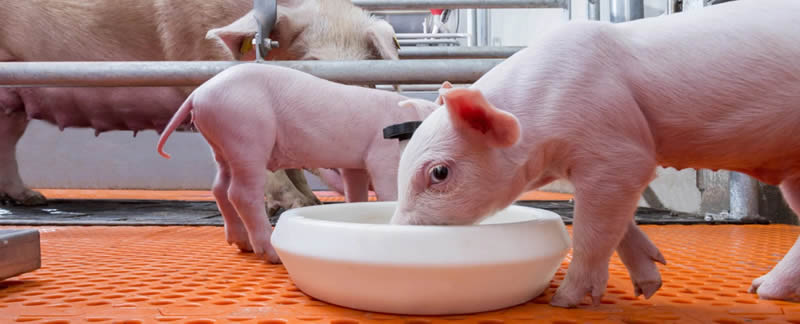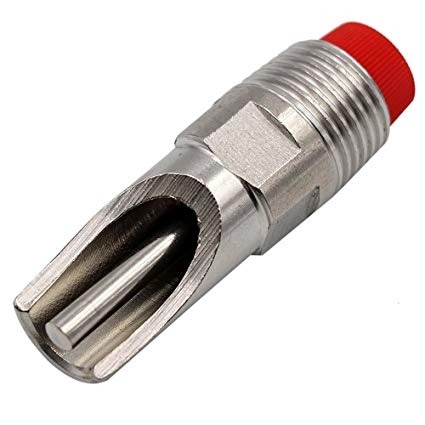Water in the farm has many roles and is one of the most important things to keep the farm running.
Regardless of the activity and production of your farm, you need water. In the case of pig farms, water is used to clean and keep the stables in good sanitary conditions. Also, water is part of the cooling system that pigs need a lot, especially during the hot season.
Last but not least, water is a nutrient necessary for life, and pigs need good water to stay healthy. No matter the breed you are raising, whether they are Landrace pigs, large white pigs, Berkshire pigs, or Tamworth pigs, they all base their health and normal development on water.
Keep reading and find out how water plays an important role in the pig farm.
Contents
The Importance of Water for Pigs

Water is an essential element for all living beings, and in the case of pigs, water is necessary for the vital functions and processes of the body. The massive body of the adult pig needs a lot of water since 53% of its body mass is represented by water, but it is equally important in the case of a piglet because 80% of its weight is represented by water.
By drinking the right amount of water, the pig regulates its body temperature, manages to eliminate toxins through urine, and improves digestion and transport of nutrients throughout the body while protecting its internal organs.
Pigs can survive even if they lose all the fat in their body, but they cannot stay alive if the amount of water in their body drops by 10% from the normal level.
Pig Water Quality
Clean water with the right properties is the key to a healthy animal population and the happiness of the farmer.
Pigs will drink the right amount of water and will develop properly only when the water is of good quality. The quality of water and its consumption directly influence the health of pigs, as well as their productivity. Therefore, you must carefully study and test the water source and its properties. Regardless of whether it is from the surface or the ground, the water must not be contaminated with any bacteria, chemicals, or heavy metals.
Another important factor that must be taken into account when talking about water quality is its temperature. Water for pigs must have a temperature between 50-59°F (10-15°C). If the temperature is not between the two values, then the pigs will have problems with digestion.
How to Test the Water Quality for Pigs
To have some healthy pigs, it is advisable to test the water regularly. That way, you will be in control and see if there have been changes in the water quality before it affects the animals.
To detect potential problems, you should test the water for the following:
- Water clarity – the water should be clear. If the water is cloudy, then it is possible that it contains silt or clay and you should continue with a chemical and microbiological analysis.
- Water color – If the water is clean and has a good color, then everything is fine. However, if it has an unusual color, then it means that it contains some particles that must be examined further.
- Water pH – The acidity of the water should normally fall between 6.5 – 8.0. If the pH value is lower than 6.5 or higher than 8.0, then it is possible that the water is contaminated with various particles such as copper, iron, or cadmium.
- The odor of the water – In general, the water does not have any odor, but if you feel any then this is a sign that the water is contaminated with bacteria that can make the animals sick.
- Total dissolved solids (TDS) – If you are thinking to test your water for levels of calcium, magnesium, sulfate, sodium, or chlorine, then you can use the TDS measure. A level below 1000 ppm is perfect for pigs, but everything above 5000 ppm is not good to offer to pigs.
Normal Water Consumption in Pigs
The pig is used to drinking water after being fed. The normal water consumption of a pig depends on several factors such as the composition of the feed, the temperature in the stable, and its activity.
Their active period is somewhere between 9 am and 7 pm, and they can consume between 1 -1.5 gal (3.7 and 7 l) of water per day.
| Age of pig: | Daily water requirements gallons(liters)/day |
|---|---|
| Lactating sow | 6 to 11 gal / (24 to 45 l) |
| Dry sow and boar | 3 to 4 gal / (12 to 15 l) |
| Finisher | 2 to 3 gal / (9 to 12 l) |
| Grower | 1 to 2 gal / (5 to 7 l) |
| Weaner | 0.8 to 1 gal / (3 to 5 l) |
Increased Water Consumption in Pigs
The following causes could lead to higher water consumption in pigs than usual:
- the quality of the fodder is not the best, which leads to a problem of salt concentration in the ration
- the amount of feed is not ideal and therefore the hungry pigs will drink more water due to the lack of feed
So, you should check if the fodder has the right properties and if the amounts are suitable. In this way, you will avoid wasting water and other issues with the pigs.
Low Water Consumption in Pigs
If the pigs’ water consumption is lower than normal, then you can start by checking if the watering system is working correctly. This issue must be solved quickly because the pig cannot live more than 48 hours without water.
Another cause of lower water consumption can be the illness of the pigs. If the pigs are not sick and the system is working well, then another possibility would be that the water is contaminated, and the pigs refuse to drink it.
Pigs that have not drunk enough water will visibly manifest strangely. They will begin to move in circles, their skin will turn pale, and they will begin to lose their hair and physical condition.
Types of Drinking Systems for Pigs
The ideal watering system for pigs must be chosen depending on the arrangement of the stable and the total number of animals that will use it.
Pig Nipple Water System

To drink water through the nipple system, the pig will have to learn to bite the drinking nipple for the water to be released. When the pig finishes drinking, the water flow will also stop and you will have zero water waste.
Pig Valve Water System
The pig water valve works similarly to the nipple. The pig will activate the valve by simply touching the tip of its nose to it.
Pig Water Bowl
The water bowl for pigs is usually made of plastic or steel and is equipped with a spring valve that will be activated by the pig when it drinks. When the spring valve is activated, clean water will flow into the bowl again.
Pig Water Trough
This system is similar to a bathtub or pool of water located at ground level to facilitate the watering of pigs. The trough can be filled manually or by using a float valve. One of the advantages of this type of system is that several pigs can drink water at the same time without piling on top of each other. Also, the water trough is preferred when the sows are pregnant because, during that time, they play with the valves and nipples, wasting a lot of water and dirtying the shelter.
If there are piglets around, then take care that they don’t drown by sliding into the trough. You can put some stones at the bottom to avoid this risk.
Water via Feeder
This system is a simple one that requires that the pigs have access to water through the same system through which they are fed.
How to Set Up and Maintain the Drinking System for Pigs
The pigs’ water system must be set so that it has the correct pressure and flow, but also to maintain the water at a suitable temperature for the animals. After the system has been installed, it must be checked and maintained. Regularly, it must be sanitized to minimize the risk of contaminating the water with droppings or urine and be controlled for any leaking or clogged pipe.
Regulate the Water Flow
The recommended water flow rate is 0.26 gal/min (1.5 l/ min). To test if the water flow is correct, you can use a graduated container. By using this container, you can find out exactly how long it takes to fill it.
To achieve a flow rate of 0.26 gal/min (1.5 l/ min), the container should be full in 40 seconds. If the container is not full during this time, you must check the system and see what is not working correctly.
Set Up the Right Water Pressure
The pressure of the pig water system must be moderate and constant. If the pressure is too high, then the pigs will be splashed with water and will refuse to drink it. If the pressure is low, then the pigs may be deprived of water, which will lead to their dehydration.
Check the Water Filters
After a time, a layer of bacteria forms inside the water pipes, which can lead to water contamination. The role of filters is to minimize the risk of water contamination by stopping bacteria. It is recommended that they be checked once a week. If they are dirty, they will be washed or replaced with new ones.
Check and Repair the Water Leaks
The pipes must be checked daily, and if any leaks are found, then they must be quickly resolved, otherwise, it will result in water and money waste.
The pipes must be protected from both cold and high heat. They can be buried in the ground, or isolated.
Having said that, please tell us how you manage water in your pig farm, what problems you encountered, and what solutions you found.

